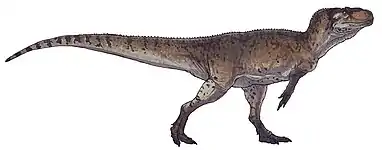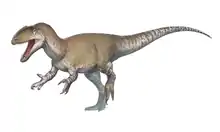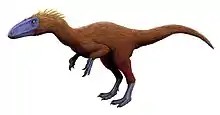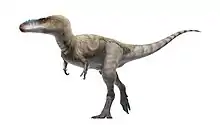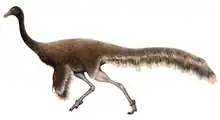| Niebla antiqua Temporal range: Late Cretaceous, | |
|---|---|
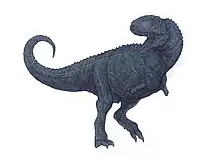 | |
| Life restoration | |
| Scientific classification | |
| Domain: | Eukaryota |
| Kingdom: | Animalia |
| Phylum: | Chordata |
| Clade: | Dinosauria |
| Clade: | Saurischia |
| Clade: | Theropoda |
| Family: | †Abelisauridae |
| Clade: | †Brachyrostra |
| Genus: | †Niebla Rolando et al., 2020 |
| Species: | †N. antiqua |
| Binomial name | |
| †Niebla antiqua Rolando et al., 2020 | |
Niebla is a genus of abelisaurid theropod dinosaur from the Late Cretaceous Period (Campanian-Maastrichtian)[1] of Río Negro province, Argentina. The genus contains a single species, Niebla antiqua, and is known from a partial, non-articulated skeleton. The holotype, found in the Allen Formation, represents an adult individual.[2]
Discovery and naming
The holotype, MPCN-PV-796, was found near Matadero Hill, 70 kilometres (43 mi) south of General Roca, Río Negro province, Argentina. The fossil material includes a near-complete braincase, fragmentary jaw and teeth, relatively complete scapulocoracoid, dorsal ribs and incomplete vertebrae.[2]
The genus name Niebla comes from the Spanish word for "mist", referring to the foggy days during the excavation of the fossil. The specific name, antiqua, is derived from a Latin word meaning "old."[2]
Description
Niebla represents one of the most derived abelisaurids. Despite its relatively small size, especially when compared to related dinosaurs like Carnotaurus, the holotype represents an adult. Based on the remains, Niebla would have been roughly 4–4.5 metres (13–15 ft) long.[2]
The scapulocoracoid is notably similar to that of Carnotaurus in having a posterodorsally oriented glenoid, a dorsoventrally expanded and wide coraco-scapular plate, and a very narrow and straight scapular blade. These features are very different from those of other abelisaurids, which may indicate a unique conformation of the pectoral girdle among these South American theropods.[2]
Paleoecology
Niebla is known from the Allen Formation of Argentina. The pterosaur Aerotitan, as well as theropods (Quilmesaurus, Bonapartenykus, Austroraptor), sauropods (Bonatitan, Pellegrinisaurus, Rocasaurus) and ornithopods (Lapampasaurus, Bonapartesaurus), are also known from the formation.[3]

References
- ↑ Armas, Paula, and María Lidia Sánchez. 2015. Hybrid coastal edges in the Neuquén Basin (Allen Formation, Upper Cretaceous, Argentina). Andean Geology 42. 97–113. Accessed 2018-10-02.
- 1 2 3 4 5 Aranciaga Rolando, Mauro; Cerroni, Mauricio A.; Garcia Marsà, Jordi A.; Agnolín, Federico L.; Motta, Matías J.; Rozadilla, Sebastián; Brisson Eglí, Federico; Novas, Fernando E. (2020-10-14). "A new medium-sized abelisaurid (Theropoda, Dinosauria) from the late cretaceous (Maastrichtian) Allen Formation of Northern Patagonia, Argentina". Journal of South American Earth Sciences. 105: 102915. doi:10.1016/j.jsames.2020.102915. hdl:11336/150468. ISSN 0895-9811. S2CID 225123133.
- ↑ "Allen Formation - Pteros".

.jpg.webp)

